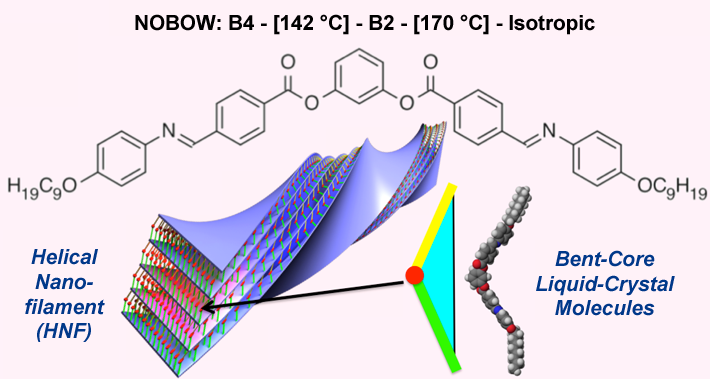Liquid crystals have many versatile applications but are best known for the liquid-crystal displays that drive the billion-dollar smartphone and flat-screen industries. Chirality, the absence of inversion symmetry, plays an important role in chemistry, biology, and materials science. Introducing molecular chirality into a liquid crystal may lead to a twisting force that can modify the equilibrium state usually observed in liquid crystals, resulting in various helical structures. However, achiral molecules have also been observed to form helical structures—for example, the helical nanofilament (HNF) phase—due to spontaneous chiral symmetry breaking. Now, for the first time, researchers have directly measured the helical pitch of a liquid-crystal HNF at various temperatures using linearly polarized, resonant soft x-ray scattering (R-SoXS) at the ALS. The work opens the door to understanding the relationship between structure and property in important organic materials, including liquid crystals, lipid tubules, and peptoids.

The NOBOW molecule is a bent-core (banana-shaped) molecule that, despite being itself achiral, forms a chiral liquid-crystal structure (i.e. a helical nanofilament). It has been proposed that one particular phase of HNF (the B4 phase) is made up of twisted layers, indicating that not only molecular chirality but also layer chirality drive the formation of helical structures. The twisting power of molecular or layer chirality is difficult to predict but can sometimes be deduced from the helical pitch. Previous attempts to probe the helical structure of the B4 HNF phase with conventional hard x-ray scattering have met with limited success because such techniques are only sensitive to electron-density modulation, which is minimal along the axis of a continuous helix.
To address this challenge, researchers applied linearly polarized, resonant soft x-ray scattering (R-SoXS) at Beamline 11.0.1.2. In typical R-SoXS experiments, the scattering contrast can be very sensitive to x-ray energy near absorption edges. Here, the researchers have gone a step further by exploiting the coupling between the linear polarization of the x-rays and the molecular bond orientations, so that the scattering contrast depends on the orientation of the molecule with respect to the x-ray polarization. Experiments were performed on drop-cast films of NOBOW in a solvent (either chloroform or chlorobenzene) with horizontally and vertically polarized x-rays at two different x-ray energies. The results show a strong peak at 283.5 eV (near the carbon K-edge), corresponding to a half-pitch of about 90 nm, roughly in agreement with data from indirect TEM measurements. The peak is anisotropic, with stronger scattering perpendicular to the x-ray polarization direction.
As the NOBOW films were heated to the isotropic phase (170 °C), the peak intensity slowly increased and sharpened, suggesting that thermal annealing leads to improved ordering. Interestingly, the helical half-pitch increased, from 86 to 97 nm, before the peak intensity started to drop without changes in pitch, suggesting that the B4 helix does not continuously unwind into the flat B2 phase, but rather undergoes melting.
Surprisingly, the half-pitch of HNFs formed upon cooling from the isotropic phase is about 120 nm, much larger than before heat treatment and the same as in pure NOBOW. The observation suggests that HNFs may adopt the preferred curvature of the pure material after temperature cycling, attaining an equilibrium pitch. When a small amount of solvent molecules are mixed in during drop-casting, the HNFs apparently form with a shorter half-pitch (~86 nm), nearly 30% shorter than that obtained after temperature cycling. The researchers proposed that the addition of guest solvent molecules increases the strain in the top and bottom halves of individual layers, increasing the preferred curvature and resulting in a shorter helical pitch.
Immediate use of RSoXS in investigating other helical structures in liquid crystals is possible. Such future studies will shed light on the complex interplay between elastic forces and the orientation and chirality of the constituent molecules.

Contact: Chenhui Zhu
Research conducted by: C. Zhu, C. Wang, A.T. Young, I. Gunkel, and A. Hexemer (ALS); F. Liu (Berkeley Lab); and D. Chen, D. Walba, J. Maclennan, and N. Clark (Univ. of Colorado, Boulder).
Research funding: National Science Foundation and U.S. Department of Energy (DOE), Office of Basic Energy Sciences (BES). Operation of ALS is supported by DOE BES.
Publication about this research: C. Zhu, C. Wang, A.T. Young, F. Liu, I. Gunkel, D. Chen, D. Walba, J. Maclennan, N. Clark, and A. Hexemer, “Probing and Controlling Liquid Crystal Helical Nanofilaments,” Nano Lett. 15, 3420 (2015).
ALS SCIENCE HIGHLIGHT #322